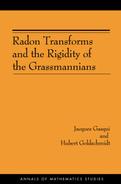From the above discussion concerning the parallel vector fields on the totally geodesic flat 2-torus Z and from the relations (6.8), we deduce the following result:
PROPOSITION 6.3. Let h be a section of ![]() over
over ![]() , with n
, with n![]() 3. The symmetric 2-form h satisfies the Guillemin condition if and only if the two symmetric 2-forms
3. The symmetric 2-form h satisfies the Guillemin condition if and only if the two symmetric 2-forms ![]() and
and![]() satisfy the Guillemin condition.
satisfy the Guillemin condition.
Let N be an odd integer ![]() 1; we consider the closed geodesic
1; we consider the closed geodesic
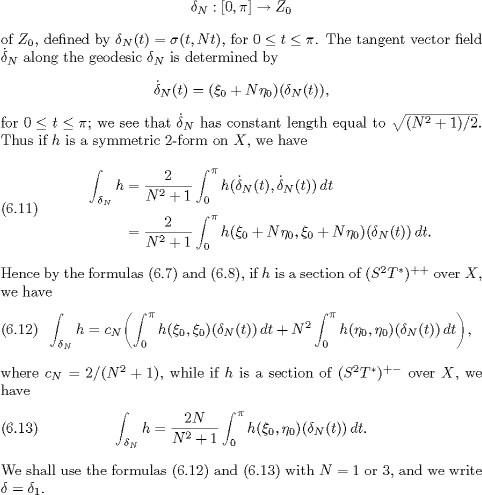
![]() 3. Symmetric forms on the complex quadric
3. Symmetric forms on the complex quadric
We now introduce certain symmetric 2-forms on X which are defined in [23![]() , 4]; we shall also recall some of their properties which are established in [23].
, 4]; we shall also recall some of their properties which are established in [23].
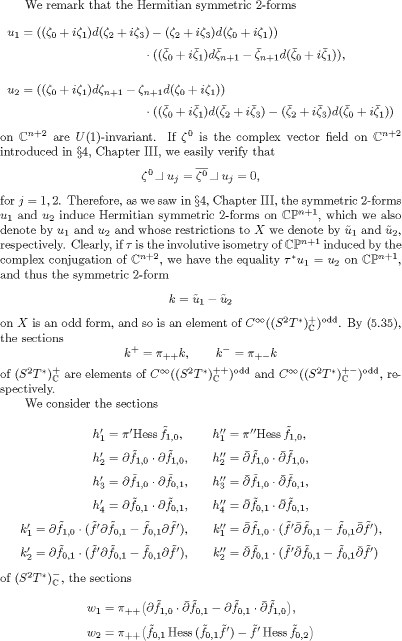
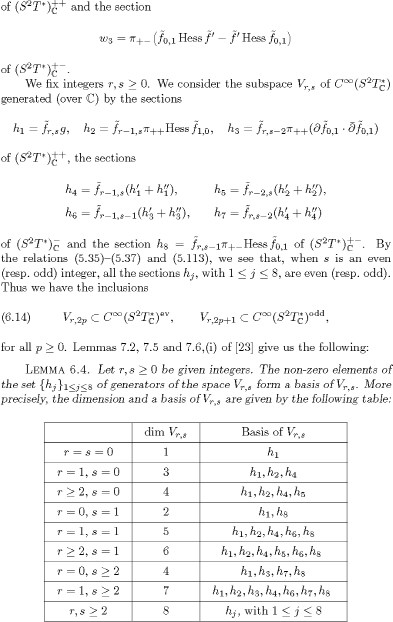

for all p 0. Lemma 7.7 of [23] asserts the following:
LEMMA 6.5. Let r, s 0 be given integers. The non-zero elements of the set of generators of the space ![]() form a basis of
form a basis of ![]() . More precisely, the dimensions and bases of the non-zero spaces
. More precisely, the dimensions and bases of the non-zero spaces ![]() are given by the following table:
are given by the following table:

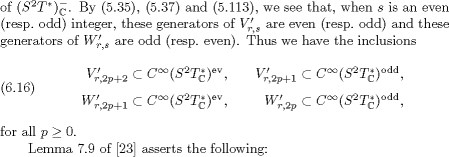
LEMMA 6.6. If ![]() the non-zero elements of the set of generators of the spaces
the non-zero elements of the set of generators of the spaces ![]() and
and ![]() form bases of these spaces. More precisely, the dimensions and bases of the non-zero spaces
form bases of these spaces. More precisely, the dimensions and bases of the non-zero spaces ![]() and
and ![]() are given by the following table:
are given by the following table:
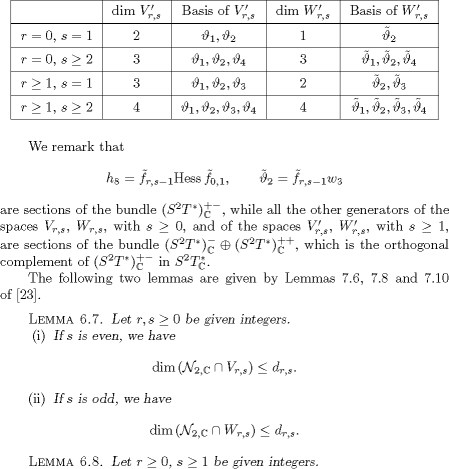
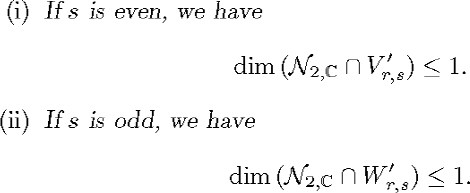
![]() 4. Computing integrals of symmetric forms
4. Computing integrals of symmetric forms
In this section and the next one, we shall compute integrals of symmetric 2-forms over specific closed geodesics of X. Each of these geodesics is contained in one of the families of flat 2-tori of X considered in [23, ![]() 4]. Thus many of the computations appearing in these two sections of this chapter are the same or similar to those of [23,
4]. Thus many of the computations appearing in these two sections of this chapter are the same or similar to those of [23,![]() 4].
4].
We consider the torus Z0 introduced in ![]() 2 and we shall use the objects associated there with this torus. In particular, we shall identify a function f on
2 and we shall use the objects associated there with this torus. In particular, we shall identify a function f on ![]() satisfying
satisfying
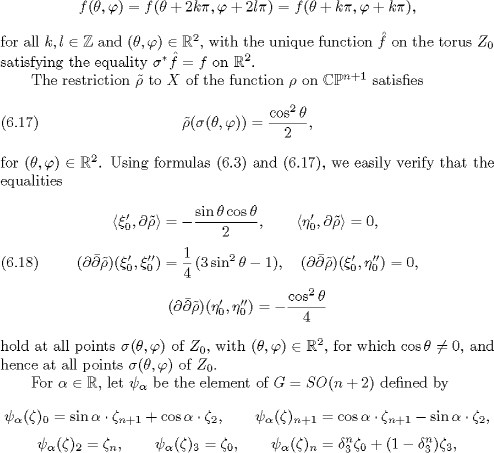
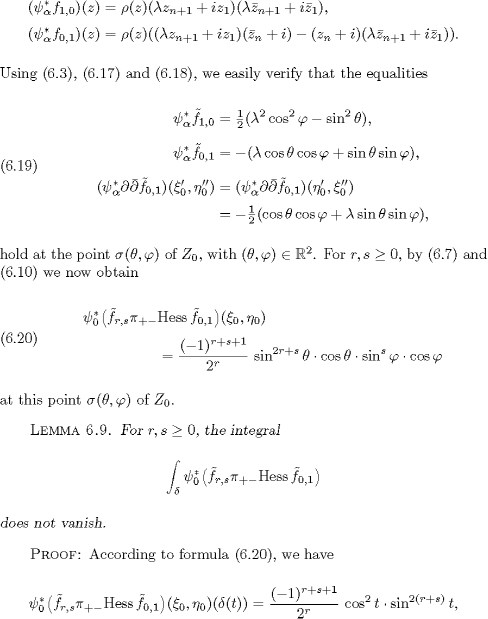
for ![]() Since cos2 t sin2(r+s) t 0, the lemma is a consequence of the equality (6.13) and the above relation.
Since cos2 t sin2(r+s) t 0, the lemma is a consequence of the equality (6.13) and the above relation.
Let ![]() be a given real number; we set
be a given real number; we set ![]() ì = cos and
ì = cos and ![]() = sin . If
= sin . If ![]() is the inclusion mapping of the complex hypersurface
is the inclusion mapping of the complex hypersurface ![]() V into V , the symmetric 2-forms
V into V , the symmetric 2-forms ![]() and
and ![]() on
on ![]() satisfy the relations
satisfy the relations
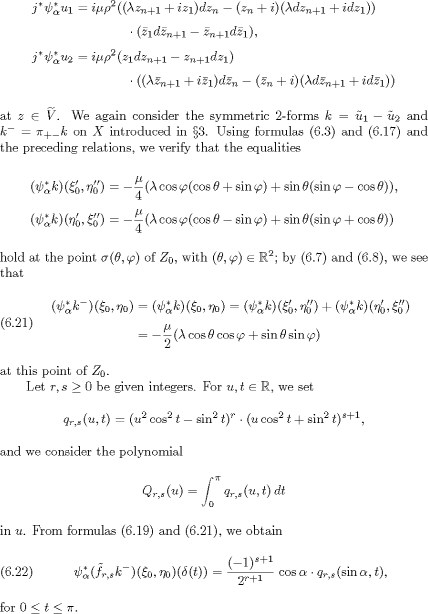
LEMMA 6.10. Let r, s ![]() 0 be given integers. Then there exists
0 be given integers. Then there exists ![]() 0
0

does not vanish.
PROOF: The coefficient of ![]() of the polynomial
of the polynomial ![]() is equal
is equal

which is positive, and so the polynomial ![]() is non-zero. Hence there exists a real number
is non-zero. Hence there exists a real number ![]() such that the expressions cos 0 and
such that the expressions cos 0 and ![]() do not vanish. Therefore by (6.12) and (6.22), we infer that the integral of the lemma corresponding to this element
do not vanish. Therefore by (6.12) and (6.22), we infer that the integral of the lemma corresponding to this element ![]() does not vanish.
does not vanish.
Let ![]() be the element of G defined by
be the element of G defined by
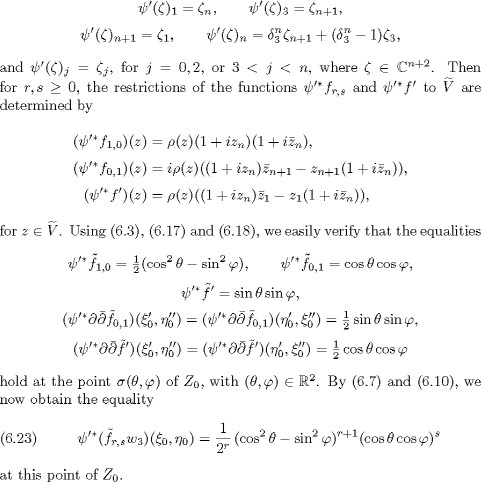
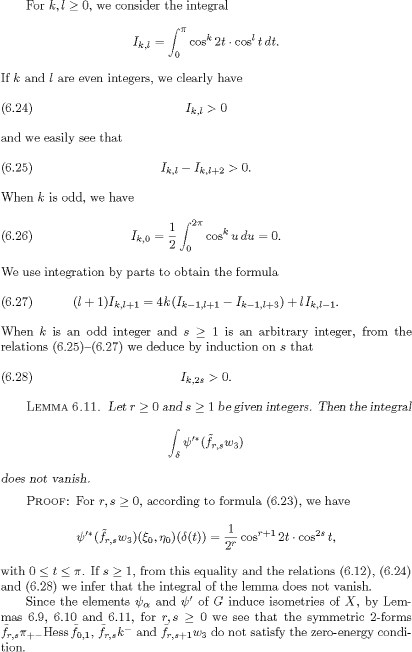
![]() 5. Computing integrals of odd symmetric forms
5. Computing integrals of odd symmetric forms
This section is a continuation of the preceding one. Its results will only be used in the proofs of the lemmas of 6,![]() which we require for Propositions 6.28 and 6.34 and for Theorem 6.36. This last theorem is needed in
which we require for Propositions 6.28 and 6.34 and for Theorem 6.36. This last theorem is needed in ![]() 8 to establish the infinitesimal rigidity of the quadric
8 to establish the infinitesimal rigidity of the quadric ![]() of dimension 3.
of dimension 3.
If k, l 0 are given integers, we set
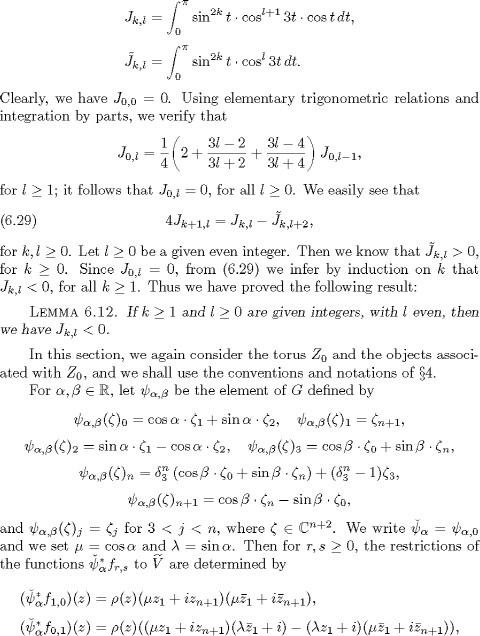
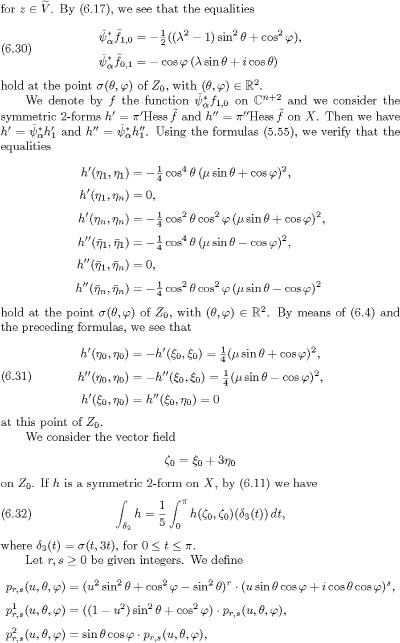

does not vanish.
LEMMA 6.14. Let ![]() r 0 and s 2 be given integers, with s even. Then there exists
r 0 and s 2 be given integers, with s even. Then there exists ![]() such that the integral
such that the integral

does not vanish.
Let r 0 and s 1 be given integers. Since the elements![]() of G induce isometries of X, according to Lemmas 6.13 and 6.14, the symmetric
of G induce isometries of X, according to Lemmas 6.13 and 6.14, the symmetric
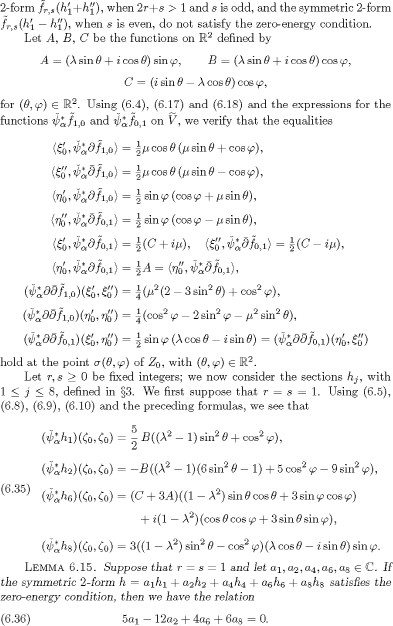
PROOF: By formulas (6.32) and (6.35), there exists an explicit polynomial P(u) of degre![]() e 3 in u such that
e 3 in u such that

holds.
PROOF: By formulas (6.32) and (6.37), there exists an explicit polynomial ![]() of degree 3 in u such that
of degree 3 in u such that

for ![]() moreover, we verify that the coefficient of u2 of
moreover, we verify that the coefficient of u2 of ![]() is equal to
is equal to
![]()
If the symmetric 2-form h satisfies the zero-energy condition, the polynomial Q vanishes and so, by Lemma 6.12, we obtain the relation (6.38).

PROOF: By (6.30) and the formulas involvin![]() g which appear after Lemma 6.15, we obtain expressions for the functions
g which appear after Lemma 6.15, we obtain expressions for the functions![]() on Z0, with 1
on Z0, with 1 ![]() j 8. By the relations (6.11)–(6.13), with N = 1, there exists an explicit polynomial P(u) of degree
j 8. By the relations (6.11)–(6.13), with N = 1, there exists an explicit polynomial P(u) of degree![]() in u such that
in u such that

for ![]() all R. Since the symmetric 2-form h satisfies the zero-energy condition, this polynomial P vanishes. The vanishing of the
coefficient of
all R. Since the symmetric 2-form h satisfies the zero-energy condition, this polynomial P vanishes. The vanishing of the
coefficient of![]() of P(u) gives us the relation (6.41). Next, we give equalities analogous to those appearing after Lemma 6.14, with
of P(u) gives us the relation (6.41). Next, we give equalities analogous to those appearing after Lemma 6.14, with![]() replaced by the element
replaced by the element![]() of G defined in
of G defined in ![]() 4. Then by (6.19) and these formulas, we obtain expressions for the functions
4. Then by (6.19) and these formulas, we obtain expressions for the functions![]() on Z0, with 1 j
on Z0, with 1 j ![]() 8. Using relations (6.11)–(6.13), with N = 1, we compute an explicit polynomial
8. Using relations (6.11)–(6.13), with N = 1, we compute an explicit polynomial ![]() of degree
of degree ![]() in u such that
in u such that

for ![]() Our hypotheses imply that this polynomial
Our hypotheses imply that this polynomial ![]() vanishes. The vanishing of the coefficient of
vanishes. The vanishing of the coefficient of ![]() (resp. of gives us the relation (6.39) (resp. the relation (6.40)). Moreover, when r is odd, the equality (-
(resp. of gives us the relation (6.39) (resp. the relation (6.40)). Moreover, when r is odd, the equality (-![]() = 0 is equivalent to (6.42), while the equality
= 0 is equivalent to (6.42), while the equality ![]() = 0 is equivalent to (6.43). On the other hand, when r is even, the equality Q(1) = 0 is equivalent to (6.44), while the
equality
= 0 is equivalent to (6.43). On the other hand, when r is even, the equality Q(1) = 0 is equivalent to (6.44), while the
equality ![]() = 0 is equivalent to (6.45).
= 0 is equivalent to (6.45).
Let r, s 0 be fixed integers; we now consider the sections ![]() with
with ![]() defined in 3.
defined in 3.
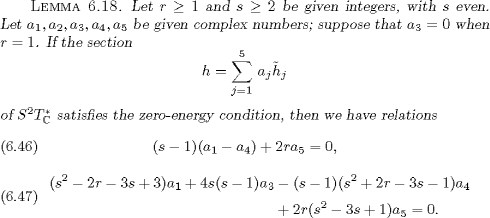
PROOF: We first derive equalities analogous to (6.30) and to those appearing after Lemma 6.14, wit![]() h replaced by
h replaced by ![]() , with
, with ![]() Since we ha
Since we ha![]() ve = ,0, these new formulas generalize those given above; we also remark that
ve = ,0, these new formulas generalize those given above; we also remark that ![]() . We then obtain expressions for the ,functions
. We then obtain expressions for the ,functions ![]() and
and
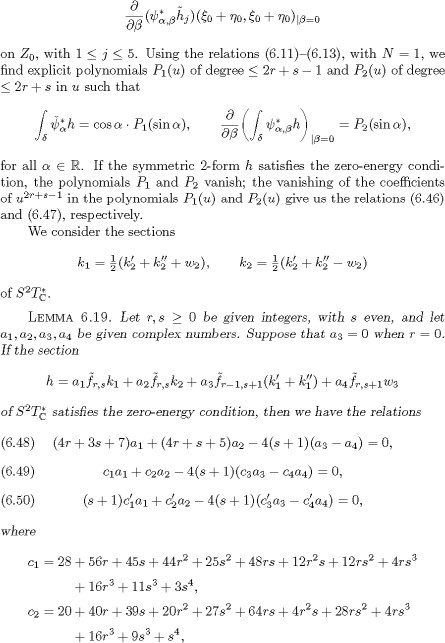

for all ![]() If the symmetric 2-form h satisfies the zero-energy condition, the polynomials Q1 and Q2 vanish; the vanishing of the coefficients
of
If the symmetric 2-form h satisfies the zero-energy condition, the polynomials Q1 and Q2 vanish; the vanishing of the coefficients
of ![]() and
and ![]() in the polynomial Q1(u) give us the relations (6.48) and (6.49), respectively, while the vanishing of the coefficient of
in the polynomial Q1(u) give us the relations (6.48) and (6.49), respectively, while the vanishing of the coefficient of![]() in the polynomial Q2(u) give us the relation (6.50).
in the polynomial Q2(u) give us the relation (6.50).
LEMMA 6.20. Let r, s 0 be given integers, with s even, and let a1, a2, a3, a4 be given complex numbers. Suppose that a3 = 0 when r = 0, and that a4 = 0 when s = 0. If the section
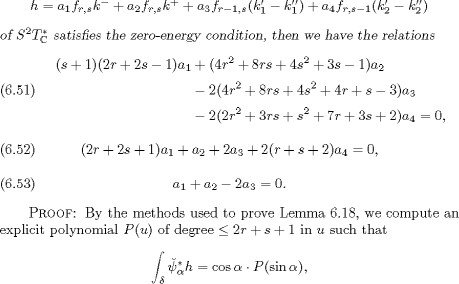
for ![]() Here we require formulas (6.19) and (6.21) and certain formulas used in proving Lemma 6.17. The equality P(0) = 0 is equivalent
to (6.52), while the equality
Here we require formulas (6.19) and (6.21) and certain formulas used in proving Lemma 6.17. The equality P(0) = 0 is equivalent
to (6.52), while the equality ![]() = 0 is equivalent to (6.51). On the other hand, when r is even, the equality P(1) = 0 is equivalent to (6.53). When r is
odd, the equality P(-1) = 0 is equivalent to the relation
= 0 is equivalent to (6.51). On the other hand, when r is even, the equality P(1) = 0 is equivalent to (6.53). When r is
odd, the equality P(-1) = 0 is equivalent to the relation
![]()
We easily see that the relations (6.52) and (6.54) imply that (6.53) holds. If the symmetric 2-form h satisfies the zero-energy condition, the polynomial P vanishes, and we obtain the desired equalities.
LEMMAS 6.17–6.20 are due to Tela Nlenvo; details of the proofs of these lemmas can be found in [52].
![]() 6. Bounds for the dimensions of spaces of symmetric forms
6. Bounds for the dimensions of spaces of symmetric forms
In this section, we use the results of ![]() 4 and 5 to give bounds for the dimension of certain spaces which we shall need in
4 and 5 to give bounds for the dimension of certain spaces which we shall need in![]() 7.
7.
LEMMA 6.21. Let r, s 0 be given integers, with s even. Then we have
![]()
PROOF: For r ![]() 1, s 2, the determinant of the
1, s 2, the determinant of the ![]() matrix, whose entries are the coefficients of a1, a2 and a3 in the relations (6.51), (6.52) and (6.53), is equal to
matrix, whose entries are the coefficients of a1, a2 and a3 in the relations (6.51), (6.52) and (6.53), is equal to
![]()
If r = 0 and s ![]() 2 (resp. if r 1 and s = 0), the relations (6.51) and (6.52), with a3 = 0 (resp. with a4 = 0), are clearly linearly independent.
Finally, if r = s = 0, the relations (6.51), (6.52) and (6.53) reduce to a1 + a2 = 0. We remark that the symmetric 2-form
h of Lemma 6.20 is an element of
2 (resp. if r 1 and s = 0), the relations (6.51) and (6.52), with a3 = 0 (resp. with a4 = 0), are clearly linearly independent.
Finally, if r = s = 0, the relations (6.51), (6.52) and (6.53) reduce to a1 + a2 = 0. We remark that the symmetric 2-form
h of Lemma 6.20 is an element of ![]() From Lemmas 6.6 and 6.20, we then deduce the desired inequality.
From Lemmas 6.6 and 6.20, we then deduce the desired inequality.
LEMMA 6.22. Let r, s 0 be given integers, with s even. Then we have
![]()
PROOF: If r 1, the determinant of the ![]() matrix, whose entries are the coefficients of a2, a3 and a4 in the relations (6.48), (6.49) and (6.50), is equal to
matrix, whose entries are the coefficients of a2, a3 and a4 in the relations (6.48), (6.49) and (6.50), is equal to
![]()
If r = 0, the relations (6.48) and (6.50), with a3 = 0, are linearly independent; in fact, the determinant of the ![]() matrix, whose entries are the coefficients of a2 and a4 in these two relations, is equal to -8(s + 1)2. We remark that the
symmetric 2-form h of Lemma 6.19 is an element of
matrix, whose entries are the coefficients of a2 and a4 in these two relations, is equal to -8(s + 1)2. We remark that the
symmetric 2-form h of Lemma 6.19 is an element of ![]() From Lemmas 6.6 and 6.19, we then obtain the desired inequality.
From Lemmas 6.6 and 6.19, we then obtain the desired inequality.
LEMMA 6.23. Let r, s 0 be given integers, with s even. Then we have
![]()
PROOF: If r, s 2, the determinant of the ![]() matrix, whose entries are the coefficients of a3 and a4 in the relations (6.46) and (6.47), is equal to the non-zero expression
4s(s - 1)2. If r = 1 and s 2, or if r
matrix, whose entries are the coefficients of a3 and a4 in the relations (6.46) and (6.47), is equal to the non-zero expression
4s(s - 1)2. If r = 1 and s 2, or if r ![]() 2 and s = 0, the relation (6.46) is non-trivial. We note that the relations (6.46) and (6.47) do not involve the coefficient
a2; when r
2 and s = 0, the relation (6.46) is non-trivial. We note that the relations (6.46) and (6.47) do not involve the coefficient
a2; when r ![]() 1 and s
1 and s ![]() 2, according to Lemma 6.14, the symmetric 2-form
2, according to Lemma 6.14, the symmetric 2-form ![]() which belongs to
which belongs to ![]() does not satisfy the zero-energy condition. We remark that the symmetric 2-form h of Lemma 6.18 is an element of
does not satisfy the zero-energy condition. We remark that the symmetric 2-form h of Lemma 6.18 is an element of ![]() These observations, together with Lemmas 6.5 and 6.18, give us the desired inequality.
These observations, together with Lemmas 6.5 and 6.18, give us the desired inequality.
LEMMA 6.24. Let r![]() 0, s 1 be given integers, with s odd. Then we have
0, s 1 be given integers, with s odd. Then we have
![]()
PROOF: We note that the relations (6.39)–(6.45) do not involve the coefficient ![]() when r 1 and 2r + s - 3 > 0, according to Lemma 6.13, the symmetric 2-form h4, which belongs to
when r 1 and 2r + s - 3 > 0, according to Lemma 6.13, the symmetric 2-form h4, which belongs to ![]() does not satisfy the zero-energy condition. Also the symmetric 2-form h of Lemma 6.17 is an element of
does not satisfy the zero-energy condition. Also the symmetric 2-form h of Lemma 6.17 is an element of ![]() r,s.
r,s.
(i) We first consider the case when r, s 3 and r is odd. In view of the above observations and Lemmas 6.4 and 6.17, it suffices
to show that the ![]() matrix, corresponding to the linear system consisting of the equations (6.39)–(6.43) in the scalars aj , with 1
matrix, corresponding to the linear system consisting of the equations (6.39)–(6.43) in the scalars aj , with 1 ![]() j 8 and j
j 8 and j ![]() = 4, is of maximal rank. The determinant of the
= 4, is of maximal rank. The determinant of the![]() matrix, whose entries are the coefficients of the aj , with j = 1 and 5
matrix, whose entries are the coefficients of the aj , with j = 1 and 5 ![]() in these relations, is equal to
in these relations, is equal to
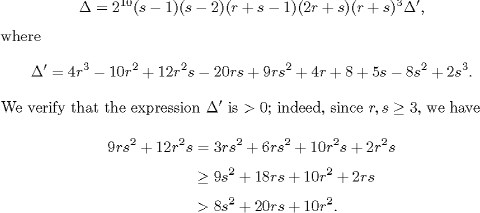
Therefore the determinant![]() is > 0 and our 5 ×
is > 0 and our 5 × ![]() 7 matrix is of maximal rank.
7 matrix is of maximal rank.
(ii) We next consider the case when r ![]() 2 is even and s 3. In view of the observations which precede the case (i), and Lemmas 6.4 and 6.17, it suffices to show that
the
2 is even and s 3. In view of the observations which precede the case (i), and Lemmas 6.4 and 6.17, it suffices to show that
the ![]() matrix, corresponding to the linear system consisting of the equations (6.39)–(6.41), and (6.44) and (6.45) in the scalars
aj , with 1
matrix, corresponding to the linear system consisting of the equations (6.39)–(6.41), and (6.44) and (6.45) in the scalars
aj , with 1 ![]() 8 and
8 and ![]() is of maximal rank. The determinant of the 5
is of maximal rank. The determinant of the 5 ![]() × 5 matrix, whose entries are the coefficients of the aj , with j = 1 and
× 5 matrix, whose entries are the coefficients of the aj , with j = 1 and ![]() in these relations, is equal to
in these relations, is equal to
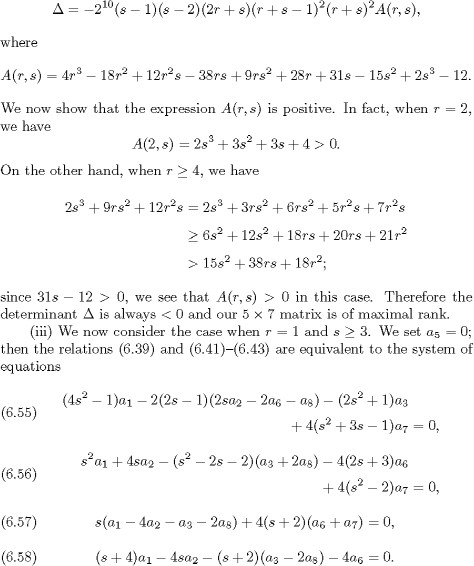
Since 2r +s-3 = s-1 > 0, in view of the observations which precede the case (i), and Lemmas 6.4 and 6.17, it suffices to show
that the![]() matrix, corresponding to the linear system consisting of equations (6.55)–(6.58) in the scalars aj , with 1
matrix, corresponding to the linear system consisting of equations (6.55)–(6.58) in the scalars aj , with 1 ![]() 8 and j
8 and j ![]() 4, 5, is of maximal rank. The determinant of the 4
4, 5, is of maximal rank. The determinant of the 4 ![]() × 4 matrix, whose entries are the coefficients of the scalars a1, a2, a3, a6 in the equations (6.55)–(6.58), is equal to
× 4 matrix, whose entries are the coefficients of the scalars a1, a2, a3, a6 in the equations (6.55)–(6.58), is equal to

Since 2r+s-3 = 2r-2 > 0, in view of the observations which precede the case (i), and Lemmas 6.4 and 6.17, when r is odd (resp.
even) it suffices to know that the ![]() matrix corresponding to the linear system consisting of equations (6.59)–(6.61) (resp. of equations (6.59), (6.60) and (6.62))
in the scalars a1, a2, a5, a6, a8 is of maximal rank. Since the determinant of the matrix
matrix corresponding to the linear system consisting of equations (6.59)–(6.61) (resp. of equations (6.59), (6.60) and (6.62))
in the scalars a1, a2, a5, a6, a8 is of maximal rank. Since the determinant of the matrix

is equal to 128r( r + 1)2), our ![]() matrix is of maximal rank when r is odd (resp. even).
matrix is of maximal rank when r is odd (resp. even).
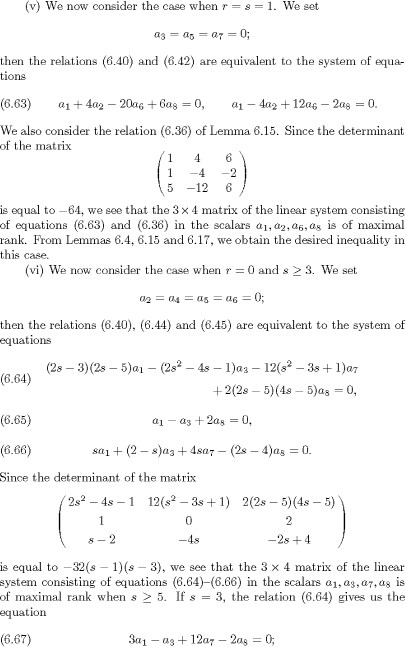
in this case, we also consider the relation (6.38) of Lemma 6.16. Since the determinant of the matrix

is equal to 104, the![]() matrix of the linear system consisting of equations (6.65), (6.67) and (6.38) in the scalars a1, a3, a7, a8 is of maximal
rank. For all s 3, we then obtain the desired inequality from Lemmas 6.4, 6.16 and 6.17.
matrix of the linear system consisting of equations (6.65), (6.67) and (6.38) in the scalars a1, a3, a7, a8 is of maximal
rank. For all s 3, we then obtain the desired inequality from Lemmas 6.4, 6.16 and 6.17.
(vii) We finally consider the case when r = 0 and s = 1. In this case, we set

and then Lemmas 6.4 and 6.17 imply the desired result.
![]() 7. The complex quadric of dimension three
7. The complex quadric of dimension three
In this section, we suppose that n = 3 and that X is the quadric ![]() of dimension 3, which is a homogeneous space of the group G = SO(5). Let be the dual of the group G.
of dimension 3, which is a homogeneous space of the group G = SO(5). Let be the dual of the group G.
The Casimir element of the Lie algebra ![]() g0 of G operates by a scalarcon
g0 of G operates by a scalarcon ![]() an irreducible G-module which is a representativ
an irreducible G-module which is a representativ![]() e of . We know that,
e of . We know that, ![]() for , the G-module
for , the G-module ![]() is an eigenspace of the Lich-nerowicz Laplacia
is an eigenspace of the Lich-nerowicz Laplacia![]() n with eigenvalue = 12c. If W is a G-submodule of
n with eigenvalue = 12c. If W is a G-submodule of ![]() with , we denote by C(W) the weight subspace of W corresponding to its highest weight ;
with , we denote by C(W) the weight subspace of W corresponding to its highest weight ;![]() we recall that the multiplicity of the G-module W is equal to the dimension of the space C(W).
we recall that the multiplicity of the G-module W is equal to the dimension of the space C(W).

From the branching law for SO(5) and its subgroup K described in Theorem 1.2 of [54], using the computation of the highest
weights of the irreducible K-modules given in![]() 7, Chapter V, we obtain the following result given by Proposition 9.1 of [23] (see also [54,
7, Chapter V, we obtain the following result given by Proposition 9.1 of [23] (see also [54, ![]() 4]):
4]):
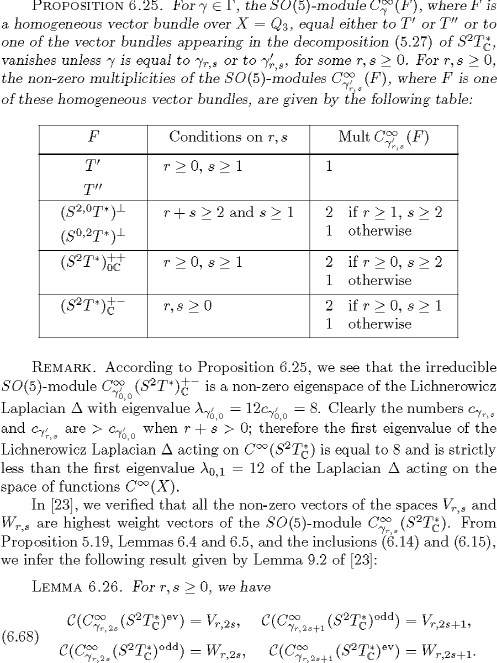
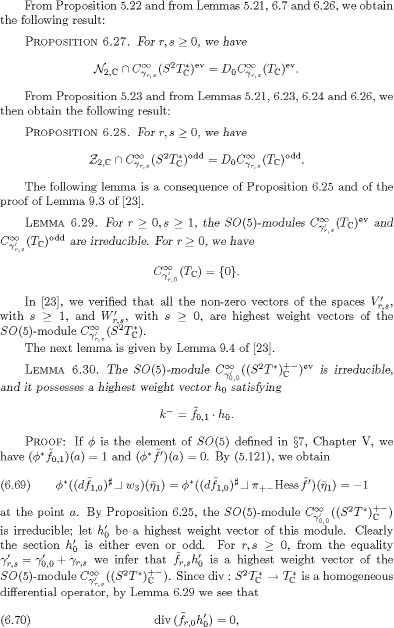

![]()
Moreover since the section h is either even or odd, we know that one (and only one) of the coefficients c1, c2 must vanish. If c2 = 0, then from (6.71) we obtain the relation
![]()
which contradicts (6.69). Therefore we must have c1 = 0, and the vector h is a non-zero multiple of k- and so is an odd section
of ![]() Hence the vector
Hence the vector ![]() satisfies the conclusion of the lemma.
satisfies the conclusion of the lemma.
For r 0, the highest weight vector![]() of the SO(5)-module C
of the SO(5)-module C![]() ((S2T)C+-)ev generates (over
((S2T)C+-)ev generates (over ![]() C) a subspace
C) a subspace ![]() V r,0 of this module. By Lemma 6.30 we have
V r,0 of this module. By Lemma 6.30 we have
![]()
for r, s 0, and so the symmetric 2-form ![]() belongs to the subspace
belongs to the subspace ![]() for all r, s 0.
for all r, s 0.
From Proposition 6.25, Lemma 6.6, the inclusions (6.16) and the remark preceding Lemma 6.30, we deduce the following result given by Lemma 9.5 of [23]:
LEMMA 6.31. For r, ![]() s 0, we have
s 0, we have

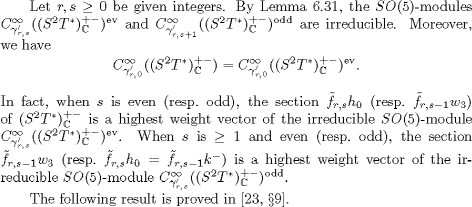
LEMMA 6.32. For r,![]() s 0, with s even, the symmetric 2-form
s 0, with s even, the symmetric 2-form ![]() on X does not satisfy the Guillemin condition.
on X does not satisfy the Guillemin condition.
For r 0, we have ![]() From Proposition 5.22 and from Lemmas 6.8, 6.29, 6.31 and 6.32, we then obtain the following result:
From Proposition 5.22 and from Lemmas 6.8, 6.29, 6.31 and 6.32, we then obtain the following result:
PROPOSITION 6.33. For r, ![]() s 0, we have
s 0, we have

We now complete the proof of the following result of [23].
THEOREM 6.35. An even symmetric 2-form on the quadric X = ![]() satisfies the Guillemin condition if and only if it is a Lie derivative of the metric.
satisfies the Guillemin condition if and only if it is a Lie derivative of the metric.
PROOF: From Proposition 2.30,(i), with ![]() , and
, and ![]() and Propositions 6.25, 6.27 and 6.33, we obtain the equality
and Propositions 6.25, 6.27 and 6.33, we obtain the equality
![]()
which implies the desired result.
The following is a consequence of joint work with Tela Nlenvo (see [52] and ![]() 5).
5).
THEOREM 6.36. An odd symmetric 2-form on the quadric ![]() satisfies the zero-energy condition if and only if it is a Lie derivative of the metric.
satisfies the zero-energy condition if and only if it is a Lie derivative of the metric.
PROOF: From Proposition 2.30,(ii), with ![]() and
and ![]() and Propositions 6.25, 6.28 and 6.34, we obtain the equality
and Propositions 6.25, 6.28 and 6.34, we obtain the equality
![]()
which implies the desired result.
Let r, s 0 be given integers. By Lemma 4.5 of [23], when s 2 is even, the highest weight vector
![]()
PROPOSITION 6.37. Let X be the complex quadric Q3. For ![]() r, s 0, we have
r, s 0, we have
![]()
The following theorem is a direct consequence of Propositions 5.24, 6.25 and 6.37.
THEOREM 6.38. An even section of ![]() over the quadric
over the quadric ![]() which satisfies the Guillemin condition, vanishes identically.
which satisfies the Guillemin condition, vanishes identically.
Let r 0, s ![]() 1 be given integers. By Lemma 6.9, when s is an odd integer, the highest weight vector
1 be given integers. By Lemma 6.9, when s is an odd integer, the highest weight vector
![]()
PROPOSITION 6.39. Let X be the complex quadric Q3. For r, s 0, we have
![]()
The following theorem is a direct consequence of Propositions 5.25, 6.25 and 6.39.
THEOREM 6.40. An odd section of ![]() over the quadric Q3, which satisfies the zero-energy condition, vanishes identically.
over the quadric Q3, which satisfies the zero-energy condition, vanishes identically.
8. The rigidity of the complex quadric
In this section, we assume that X is the complex quadric ![]() with n 3, and we extend the main results of
with n 3, and we extend the main results of![]() 7 to the quadric Qn; in particular, we shall prove the four following theorems.
7 to the quadric Qn; in particular, we shall prove the four following theorems.
THEOREM 6.41. An even symmetric 2-form on the quadric X = Qn, with n![]() 3, satisfies the Guillemin condition if and only if it is a Lie derivative of the metric.
3, satisfies the Guillemin condition if and only if it is a Lie derivative of the metric.
THEOREM 6.42. An odd symmetric 2-form on the quadric X = Qn, with n![]() 3, satisfies the zero-energy condition if and only if it is a Lie derivative of the metric.
3, satisfies the zero-energy condition if and only if it is a Lie derivative of the metric.
THEOREM 6.43. An even section of ![]() over the quadric Qn, with n
over the quadric Qn, with n![]() 3, which satisfies the Guillemin condition, vanishes identically.
3, which satisfies the Guillemin condition, vanishes identically.
THEOREM 6.44. An odd section of (![]() over the quadric Qn, with n
over the quadric Qn, with n![]() 3, which satisfies the zero-energy condition, vanishes identically.
3, which satisfies the zero-energy condition, vanishes identically.
From Theorems 6.41 and 6.42, we shall deduce the following:
THEOREM 6.45. The complex quadric X = Qn, with n![]() 3, is infinitesimally rigid.
3, is infinitesimally rigid.
From Theorems 6.43 and 6.44, we shall deduce the following:
THEOREM 6.46. A section of ![]() over the complex quadric Qn, with n
over the complex quadric Qn, with n![]() 3, which satisfies the zero-energy condition, vanishes identically.
3, which satisfies the zero-energy condition, vanishes identically.
We now prove these last two theorems simultaneously. Let h be a symmetric 2-form on X satisfying the zero-energy condition.
We write ![]() where
where

section of ![]() so are the forms h+ and h-. By Lemma 2.11, the even form h+ satisfies the Guillemin condition. First, by Theorems 6.41 and
6.42 we know that the even form h+ and the odd form h- are Lie derivatives of the metric. Finally, if h is a section of
so are the forms h+ and h-. By Lemma 2.11, the even form h+ satisfies the Guillemin condition. First, by Theorems 6.41 and
6.42 we know that the even form h+ and the odd form h- are Lie derivatives of the metric. Finally, if h is a section of ![]() by Theorems 6.43 and 6.44 we know that the forms h+ and h- vanish.
by Theorems 6.43 and 6.44 we know that the forms h+ and h- vanish.
From Theorems 6.41 and 6.43, and from Propositions 2.18 and 2.21, with![]() and F = E =
and F = E = ![]() we deduce the following two results:
we deduce the following two results:
THEOREM 6.47. The real Grassmannian Y = ![]() with n
with n![]() 3, is rigid in the sense of Guillemin.
3, is rigid in the sense of Guillemin.
THEOREM 6.48. A section of the vector bundle EY over the real Grassmannian ![]() with n
with n![]() 3, which satisfies the Guillemin condition, vanishes identically.
3, which satisfies the Guillemin condition, vanishes identically.
![]()
of submanifolds of X and we saw that a submanifold of X belonging to Fis isometric to the complex quadric ![]() of dimension 3.
of dimension 3.
From Lemma 4.8, with p = 2 and q = 3, we obtain:
LEMMA 6.49. Let X be the complex quadric ![]() with n
with n![]() 3. Let
3. Let
xx![]() and h be an element of
and h be an element of ![]() If the restriction of h to an arbitrary submanifold of the family
If the restriction of h to an arbitrary submanifold of the family ![]() Fvanishes, then h vanishes.
Fvanishes, then h vanishes.
PROPOSITION 6.50. Let h be a symmetric 2-form on the quadric X = Qn, with ![]() n 3.
n 3.
PROOF: We consider the complex quadric Z = ![]() of dimension 3. Let
of dimension 3. Let ![]() be a submanifold of X belonging to the family
be a submanifold of X belonging to the family ![]() According to Lemma 4.6 and the equality (5.64), there is a totally geodesic imbedding
According to Lemma 4.6 and the equality (5.64), there is a totally geodesic imbedding ![]() whose image is equal to
whose image is equal to ![]() and which possesses the following properties:
and which possesses the following properties:
We note that Proposition 6.50,(iii) gives us Theorems 6.43 and 6.44. We therefore know that Theorem 6.46 also holds.
We consider the G-invariant family F = F1 of closed connected totally geodesic surfaces of X defined in 6, Chapter V; there
we saw that each surface of F is contained in a totally geodesic submanifold belonging to the family ![]() and that all the totally geodesic flat 2-tori of X belong to the family F. Thus any closed geodesic of X is contained in
a totally geodesic surface of X belonging to the family F; it follows that
and that all the totally geodesic flat 2-tori of X belong to the family F. Thus any closed geodesic of X is contained in
a totally geodesic surface of X belonging to the family F; it follows that
![]()
According to the inclusion (6.73) and Theorem 6.46, we know that the equality
![]()
holds. By Lemma 5.8, relation (6.74) and Proposition 5.17, we see that the families F and ![]() and the vector bundle
and the vector bundle ![]() satisfy the hypotheses of Theorem 2.48,(iii). Hence from this theorem, we deduce the following result:
satisfy the hypotheses of Theorem 2.48,(iii). Hence from this theorem, we deduce the following result:
This theorem together with the first two parts of Proposition 6.50 implies Theorems 6.41 and 6.42. According to the proofs
of Theorem 2.45,(iii) and Proposition 6.50, we see that the only results of![]() 7 which we require for the proof of Theorem 6.41 (resp. Theorem 6.42) are Theorems 6.35 and 6.38 (resp. Theorem 6.36 and
6.40).
7 which we require for the proof of Theorem 6.41 (resp. Theorem 6.42) are Theorems 6.35 and 6.38 (resp. Theorem 6.36 and
6.40).
None of our results concerning forms on the quadric satisfying the zero-energy condition enter into our proof of Theorem 6.41
given above. Previously, in [23] we deduced Theorem 6.41 for the quadric ![]() with n 4, from Theorem 6.35 by means of the infinitesimal rigidity of this quadric. In fact, if h is an even symmetric 2-form
on X = Qn, with n 4, satisfying the Guillemin condition, by Proposition 6.50,(i) and the inclusion (6.73) we know that h satisfies
the zero-energy condition; the infinitesimal rigidity of Qn implies that h is a Lie derivative of the metric.
with n 4, from Theorem 6.35 by means of the infinitesimal rigidity of this quadric. In fact, if h is an even symmetric 2-form
on X = Qn, with n 4, satisfying the Guillemin condition, by Proposition 6.50,(i) and the inclusion (6.73) we know that h satisfies
the zero-energy condition; the infinitesimal rigidity of Qn implies that h is a Lie derivative of the metric.
From Theorems 5.27 and 6.41, we obtain the following:
THEOREM 6.52. An even section of L over the quadric ![]() with n
with n![]() 3, which satisfies the Guillemin condition, vanishes identically.
3, which satisfies the Guillemin condition, vanishes identically.
From Theorem 6.41 and the decomposition (1.11), we obtain the relation
![]()
![]() 9. Other proofs of the infinitesimal rigidity of the quadric
9. Other proofs of the infinitesimal rigidity of the quadric
In this section, we suppose that X is the complex quadric ![]() , with n 4. This section and the next one are devoted to other proofs of the infinitesimal rigidity of the quadric X =
, with n 4. This section and the next one are devoted to other proofs of the infinitesimal rigidity of the quadric X = ![]() with n 4. Some of the methods used here were introduced in [18] and [22].
with n 4. Some of the methods used here were introduced in [18] and [22].
The essential aspects of the proof of the following proposition were first given by Dieng in [10].
PROPOSITION 6.53. The infinitesimal rigidity of the quadric ![]() implies that all the quadrics Qn, with n 3, are infinitesimally rigid.
implies that all the quadrics Qn, with n 3, are infinitesimally rigid.
PROOF: We consider the G-invariant family F3 of closed connected totally geodesic surfaces of X introduced in![]() 6, Chapter V and the family
6, Chapter V and the family ![]() of closed connected totally geodesic submanifolds of X isometric to the quadric Q3 introduced in
of closed connected totally geodesic submanifolds of X isometric to the quadric Q3 introduced in![]() 6, Chapter V and in 8. According to a remark made in
6, Chapter V and in 8. According to a remark made in ![]() 6, Chapter V, we know that each surface belonging to the family F3 is contained in a totally geodesic submanifold of X belonging
to the family
6, Chapter V, we know that each surface belonging to the family F3 is contained in a totally geodesic submanifold of X belonging
to the family ![]() Assume that we know that the quadric Q3 is infinitesimally rigid; then the family
Assume that we know that the quadric Q3 is infinitesimally rigid; then the family ![]() possesses property (III) of
possesses property (III) of![]() 8, Chapter II; moreover, by Propositions 5.13 and 5.14, the families F = F3 and
8, Chapter II; moreover, by Propositions 5.13 and 5.14, the families F = F3 and ![]() satisfy the hypotheses of Theorem 2.47,(iii). From this last theorem, we deduce the infinitesimal rigidity of X.
satisfy the hypotheses of Theorem 2.47,(iii). From this last theorem, we deduce the infinitesimal rigidity of X.
We now consider the G-invariant family F = F2 of closed connected totally geodesic surfaces of X. The sub-bundle N2 = NF of
B consisting of those elements of B, which vanish when restricted to the closed totally geodesic submanifolds of F, was introduced
in![]() 8, Chapter II and was considered in
8, Chapter II and was considered in![]() 6, Chapter V. We also consider the differential operator
6, Chapter V. We also consider the differential operator
![]()
of![]() 8, Chapter II.
8, Chapter II.
We consider the families ![]() and
and ![]() of closed connected totally geodesic submanifolds of X introduced in
of closed connected totally geodesic submanifolds of X introduced in![]() 6, Chapter V and we set
6, Chapter V and we set
![]()
A submanifold of X belonging to ![]() (resp. to
(resp. to ![]() is a surface isometric to the flat 2-torus (resp. to the real projective plane
is a surface isometric to the flat 2-torus (resp. to the real projective plane ![]() , while a submanifold of X belonging to
, while a submanifold of X belonging to ![]() is isometric to the complex projective space CP2. In 6, Chapter V, we saw that each surface belonging to
is isometric to the complex projective space CP2. In 6, Chapter V, we saw that each surface belonging to ![]() is contained
is contained ![]() in a submanifold of X belonging to the family
in a submanifold of X belonging to the family ![]() therefore each surface of X belonging to F is contained in a submanifold of X belonging to the family
therefore each surface of X belonging to F is contained in a submanifold of X belonging to the family ![]() According to Proposition 3.19 and Theorems 3.7 and 3.39, we see that the family
According to Proposition 3.19 and Theorems 3.7 and 3.39, we see that the family ![]() possesses property (III) o
possesses property (III) o![]() f 8, Chapter II. Hence a symmetric 2-form h on X satisfying the zero-energy condition belongs to
f 8, Chapter II. Hence a symmetric 2-form h on X satisfying the zero-energy condition belongs to ![]() ) and, by Proposition 2.44, verifies the relation
) and, by Proposition 2.44, verifies the relation
![]()
![]()
vanishes identically.
We now give an alternate proof of Theorem 6.45, with n 4, using Propositions 6.54, 6.55 and 5.26. In the case n = 4, this
proof appears in [22]. Let h be a symmetric 2-form on the quadric X = Qn, with n 4, satisfying the zero-energy condition and
the relation div h = 0. When n 5, Proposition 6.54 tells us that h is a section of L; by Proposition 5.26, we see that h vanishes
identically. When n = 4, Proposition 6.54 tells us that h is a section of ![]() and, as we saw above, Proposition 2.44 gives us the relation
and, as we saw above, Proposition 2.44 gives us the relation ![]() by Proposition 6.55, we see that h vanishes. Then Proposition 2.13 gives us the infinitesimal rigidity of X.
by Proposition 6.55, we see that h vanishes. Then Proposition 2.13 gives us the infinitesimal rigidity of X.
Finally, we present an outline of the proof of the infinitesimal rigidity of Qn, with n 5, given in [18]. This proof completely
avoids the use of harmonic analysis on the quadric; it requires the description of the explicit complement of ![]() in the vector bundle N2 = NF given by Proposition 5.12.
in the vector bundle N2 = NF given by Proposition 5.12.
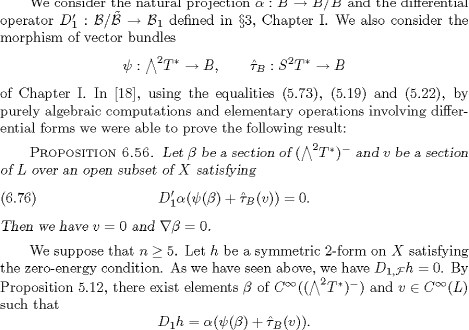
By Lemma 1.17, we obtain the relation (6.76). Then Proposition 6.56 tells us that v = 0 and![]() Since a harmonic differential 2-form on X is a constant multiple of the Kahler form of X, we immediately deduce that
Since a harmonic differential 2-form on X is a constant multiple of the Kahler form of X, we immediately deduce that![]() Thus we know that D1h = 0. We know that the sequence (1.24) is exact (see
Thus we know that D1h = 0. We know that the sequence (1.24) is exact (see![]() 6, Chapter V); therefore h is a Lie derivative of the metric. We have thus shown that the infinitesimal rigidity of the quadric
6, Chapter V); therefore h is a Lie derivative of the metric. We have thus shown that the infinitesimal rigidity of the quadric
![]() with
with ![]() is a consequence of Propositions 5.12, 5.14 and 6.56.
is a consequence of Propositions 5.12, 5.14 and 6.56.
![]() 10. The complex quadric of dimension four
10. The complex quadric of dimension four
In this section, we suppose that X is the complex quadric Q4 of dimension 4, which is a homogeneous space of the group G = SO(6), and we present an outline of the proof of Proposition 6.55.
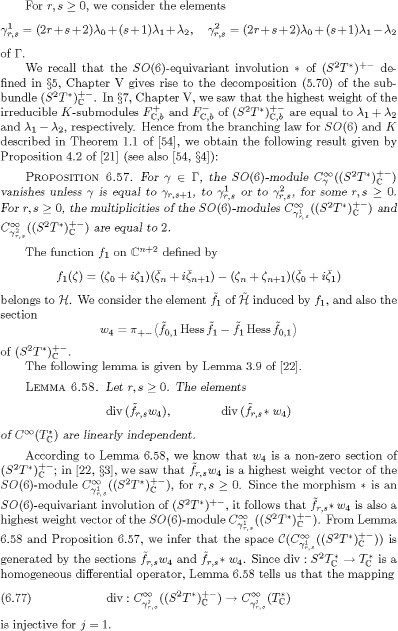
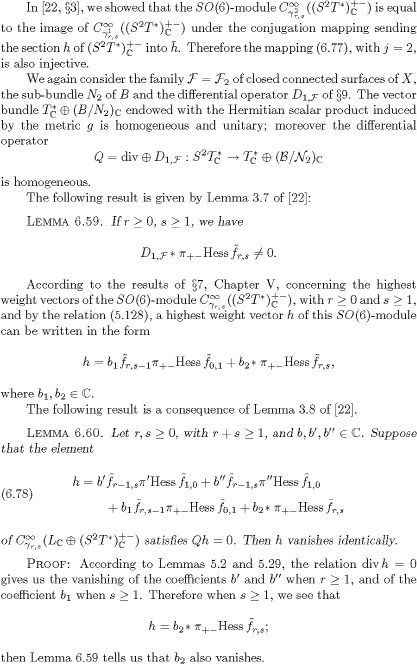
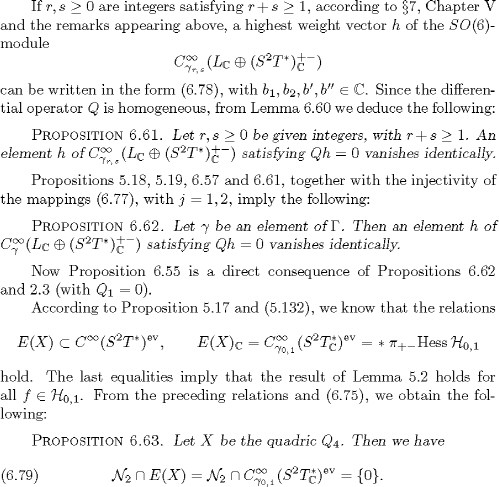
![]() 11. Forms of degree one
11. Forms of degree one
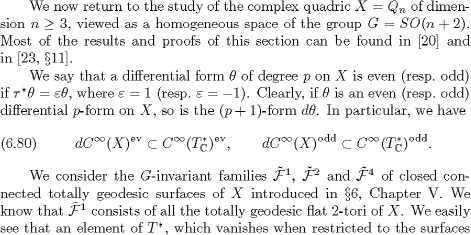

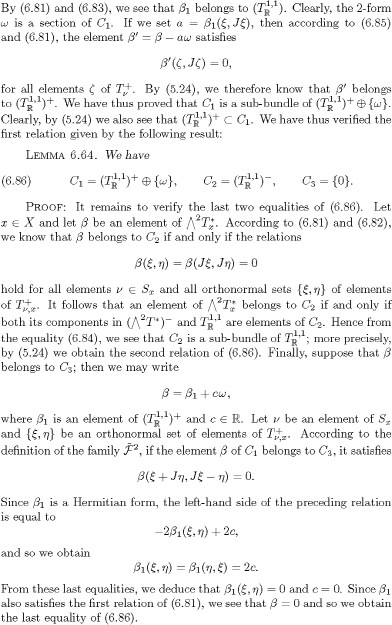
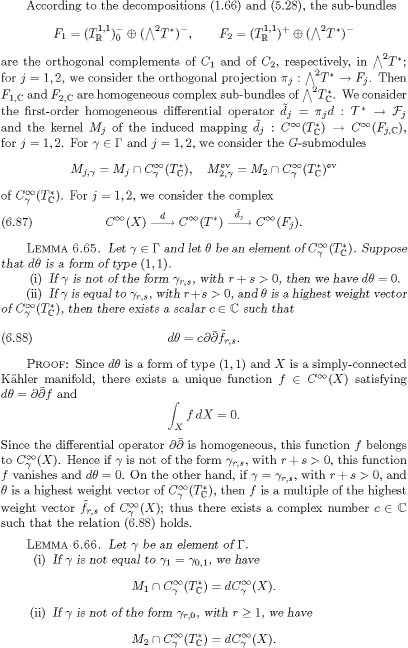
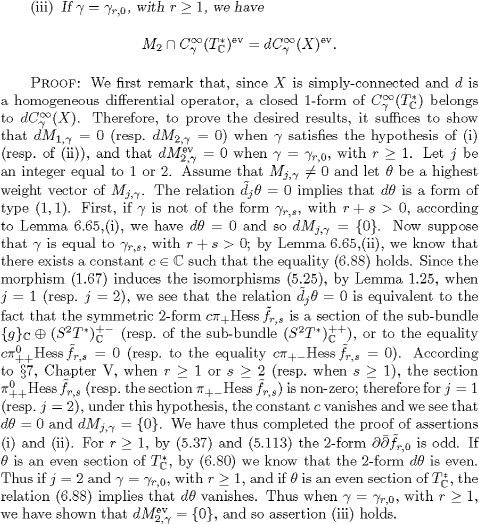
PROPOSITION 6.68. The space g(K) belongs to the kernel of ![]() and is isomorphic to the cohomology of the complex (6.87), with j = 1.
and is isomorphic to the cohomology of the complex (6.87), with j = 1.
PROOF: By Proposition 3.10,(i), we know that g![]() (K) belongs to the kernel of
(K) belongs to the kernel of ![]() Let
Let ![]() be a 1-form on X satisfying
be a 1-form on X satisfying ![]() = 0. We consider
= 0. We consider
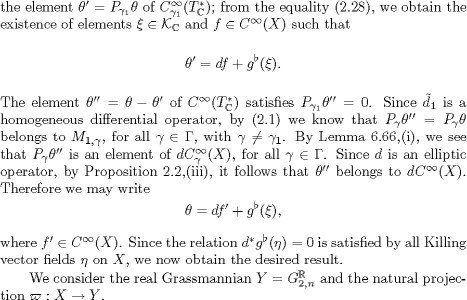
PROPOSITION 6.69. An even 1-form![]() on X satisfying the Guillemin condition verifies the relation
on X satisfying the Guillemin condition verifies the relation ![]()
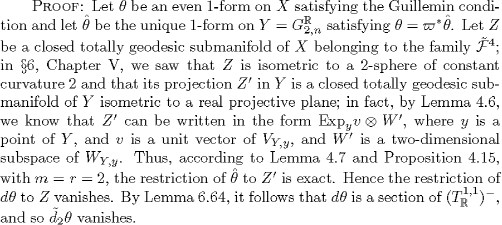
From Propositions 2.20, 6.67 and 6.69, we deduce the following two results given by Theorems 11.1 and 11.2 of [23]:
THEOREM 6.70. An even 1-form on the quadric ![]() with n
with n![]() 3, satisfies the Guillemin condition if and only if it is exact.
3, satisfies the Guillemin condition if and only if it is exact.
THEOREM 6.71. A 1-form on the Grassmannian ![]() with n
with n![]() 3, satisfies the Guillemin condition if and only if it is exact.
3, satisfies the Guillemin condition if and only if it is exact.
The following result is given by Theorem 2 of [20].
THEOREM 6.72. A 1-form on the quadric X = with n![]() 3, satisfies the zero-energy condition if and only if it is exact.
3, satisfies the zero-energy condition if and only if it is exact.
PROOF: Let ![]() be a 1-form on X satisfying the zero-energy condition. From Theorem 3.8, it follows that the restriction of
be a 1-form on X satisfying the zero-energy condition. From Theorem 3.8, it follows that the restriction of ![]() to a flat torus of X belonging to the family
to a flat torus of X belonging to the family ![]() is exact. Therefore we have
is exact. Therefore we have ![]() According to Proposition 6.68, we may write
According to Proposition 6.68, we may write
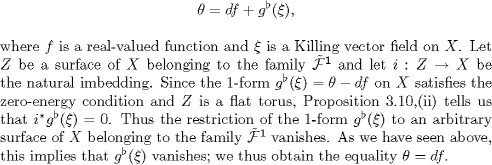
When n 4, we are able to give a proof of the preceding theorem which avoids the use of Proposition 6.68. In![]() 6, Chapter V, we saw that each surface belonging to the family F2 is contained in a submanifold belonging to the family
6, Chapter V, we saw that each surface belonging to the family F2 is contained in a submanifold belonging to the family ![]() of closed totally
of closed totally![]() geodesic submanifolds of X introduced there. Since a submanifold belonging to the family
geodesic submanifolds of X introduced there. Since a submanifold belonging to the family ![]() is isometric to the complex projective space
is isometric to the complex projective space ![]() according to Theorems 3.8 and 3.40 we know that the family
according to Theorems 3.8 and 3.40 we know that the family ![]() possesses property (VI) of 8, Chapter II. When n 4, Theorem 6.72 is thus a consequence of the last equality of (6.86) and
Theorem 2.51,(ii), with F =
possesses property (VI) of 8, Chapter II. When n 4, Theorem 6.72 is thus a consequence of the last equality of (6.86) and
Theorem 2.51,(ii), with F = ![]() and
and ![]() .
.
